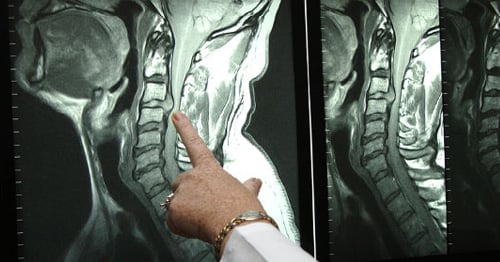Cervical Myelopathy: Spinal Cord Compression in the Neck
Nearly 10% of adults will experience some form of severe neck pain in any given calendar year.* But some injuries or degenerative conditions of the neck (the cervical portion of the spine) don't necessarily cause neck pain but, rather, lead to sensations in other parts of the body. One such condition is cervical myelopathy.
What is cervical myelopathy?
Cervical myelopathy is a disease where patients can develop balance problems impeding walking, a loss in manual dexterity as well as problems with bowel and bladder function. These symptoms can be accompanied by numbness, tingling and/or weakness in the arms and/or hands. It has an insidious course where patients can plateau in their symptoms, but overall, it is a progressive condition.
What causes cervical myelopathy?
Cervical myelopathy can be caused by a number of conditions that result from spinal cord compression. Some relatively common causes are severe cervical spondylosis (osteoarthritis of the spine) − this is known as cervical spondylotic myelopathy or CSM − and ossification of the posterior longitudinal ligament (OPLL). In OPLL, a ligament that connects the spinal vertebrae thickens and becomes inflexible.
What are the signs and symptoms of cervical myelopathy?
Usually patients with cervical myelopathy will present with balance and coordination problems, making walking difficult, and sometimes leading to manual dexterity problems (such as difficulty to button shirts). In some cases, patients can also develop problems with bowel and bladder function. These symptoms can also be accompanied by numbness, tingling or weakness in the upper extremities.
What are the common treatments for cervical myelopathy?
The common treatments for cervical myelopathy include surgical and nonsurgical options. Nonsurgical options include the use of oral corticosteroid therapy. This can result in a transient improvement in the symptoms of cervical myelopathy. Definitive treatment of cervical myelopathy is a decompression of the spinal cord via an anterior and/or posterior approach. The decision to have surgery via the different approaches will depend on where the compression of your spinal cord is as well as the overall alignment of the cervical spine and finally, patient factors. This will be determined by your surgeon.
Are there any advancements or new research that will change how cervical myelopathy is treated in the future?
Recent research into the use of the medication Riluzole on patients with myelopathy may be promising. This drug might help the spinal cord recover from the injury it has sustained from being compressed and might be useful as a medication to help the spinal cord recover after surgery to decompress the spinal cord. Further research is necessary to demonstrate its efficacy in humans, but preliminary animal studies have been promising.
Dr. Han Jo Kim is an orthopedic surgeon at Hospital for Special Surgery, specializing in cervical spine and scoliosis surgery. He is an active member of the Cervical Spine Research Society and has performed over 2000 cervical spine procedures. He believes in precision care for his patients where various surgical approaches are best fitted for the patients’ symptoms. He performs all procedures in the cervical spine, including disc replacements, fusions, anterior, posterior, high cervical and low cervical procedures. His treatment philosophy is to match right operation to the right patient based on the specific symptoms of each patient while preserving as much motion as possible for the patient and avoiding spinal fusions whenever possible.
References
- *Côté P, Cassidy JD, Carroll L. The Saskatchewan Health and Back Pain Survey. The prevalence of neck pain and related disability in Saskatchewan adults. Spine (Phila Pa 1976). 1998 Aug 1;23(15):1689-98. doi: 10.1097/00007632-199808010-00015. PMID: 9704377.
- Kim HJ, Tetreault LA, Massicotte EM, Arnold PM, Skelly AC, Brodt ED, Riew KD. Differential diagnosis for cervical spondylotic myelopathy: literature review. Spine (Phila Pa 1976). 2013 Oct 15;38(22 Suppl 1):S78-88. doi: 10.1097/BRS.0b013e3182a7eb06. PMID: 23962997.
- Rhee JM, Shamji MF, Erwin WM, Bransford RJ, Yoon ST, Smith JS, Kim HJ, Ely CG, Dettori JR, Patel AA, Kalsi-Ryan S. Nonoperative management of cervical myelopathy: a systematic review. Spine (Phila Pa 1976). 2013 Oct 15;38(22 Suppl 1):S55-67. doi: 10.1097/BRS.0b013e3182a7f41d. PMID: 23963006.


